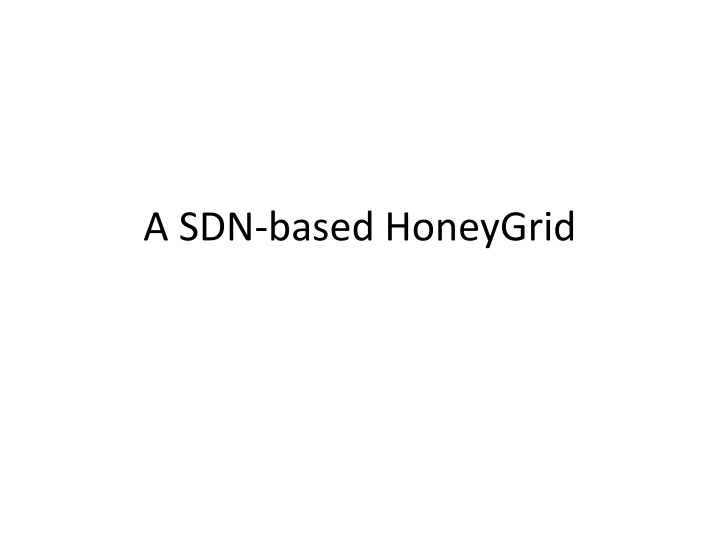
SDN-Based HoneyGrid: Innovative Resource Management Solutions
Explore the advanced goals and architecture of A SDN-based HoneyGrid, focusing on distributed resources management, NFV support, HIH and LIH combination, and protocol-independent flow migration engine. Learn about the seamless communication between controller and HIH manager for optimal resource allocation and policy updates.
Download Presentation

Please find below an Image/Link to download the presentation.
The content on the website is provided AS IS for your information and personal use only. It may not be sold, licensed, or shared on other websites without obtaining consent from the author. If you encounter any issues during the download, it is possible that the publisher has removed the file from their server.
You are allowed to download the files provided on this website for personal or commercial use, subject to the condition that they are used lawfully. All files are the property of their respective owners.
The content on the website is provided AS IS for your information and personal use only. It may not be sold, licensed, or shared on other websites without obtaining consent from the author.
E N D
Presentation Transcript
HoneyGrid Goals (cont.) 2. Distributed Resources Management through DLB NFV Deploying honeynets at multiple locations is not novel, but existing approaches either are not resource-efficient or have scalable issues. Centralize the management honeynet resources scattered over the world. Allow honeynets to join/exit dynamically. Allow resource allocation policies to get dynamically updated.
HoneyGrid Goals (cont.) 3. Support NFV apps to update policy It s hard to propose a honeynet to have all functionalities, our honeygrid should be extensible, supporting any 3-rd party implemented NFVs (e.g., IDS) to specify policies (containment policy, resource allocation policy, consistency policy )
HoneyGrid Goals 1. HIH and LIH combination. Allocating each src to a single High-interaction Honeypot (HIH) requires unaffordable resources (/17 network, 5 min for each VM, 700 VMs are required) Low-interaction Honeypot (LIH) can only emulate limited functions and can be recognized by attacker. Migrate flow from LIH to HIH when necessary. (~80% traffic are scanning traffic) Fast detect idle high-interaction honeypot (HIH) to revert for another flow.
A SDN-based HoneyGrid Protocol-independent flow migration engine. Automatically generate LIH (RolePlayer, ScriptGen) Modify OpenvSwitch to support seq number and ack number modification. Combing idle timeout and hard timeout to optimize HIH usage. Resource manager allocate resource for each flow Default: 1). HIH, local VM have high priority 2). One-src-one-dst per VM Support more advanced policy Monitor and manage newly added and obsolete resources. Asynchronous trace analyzer (3-rd party app) Containment policy generator (3-rd party app GQ)
Controller & HIH Manager Communication (normal exit) On step (3), controller tells manager HIH3 will be assigned to a client and sets a timeout (5 mins by default). When timeout event gets triggered, manager sends an NA msg to controller (4) and starts to revert HIH3 (7). When the HIH gets running with a clean state, manager sends a free msg to controller (8). When receiving a NA msg, controller deletes existing flows for that HIH; Controller also needs to update HIH table when receiving msgs from manager (2,5,9).
Controller & HIH Manager Communication (early exit) On step (1), add flow rule with a short idle timeout. Controller listens to idle timeout event (4) and updates HIH table. If the number of flows becomes zero, Controller sends revert msg (5) to HIH manager.
Evaluation 1. Daily traffic analysis (traffic analyzer) Tags for popular ports Per source report Captured binaries report 2. Flow migration Video demonstration Effectiveness analysis (percentage of scanning traffic) 3. HIH management Average alive time for HIH flow and VM Longest alive time for HIH flow
Evaluation (cont.) 4. Src priority assignment 3rd-party programs (e.g. traffic analyzer) informing controller interesting src IPs. Increase of captured data after enabling src priority 5. Throughput with/without load balancer 6. Global distribution Traffic difference among HoneyNets in different countries Throughput for flows entering into honeynet in country A but responded by honeypots located in country B.
